A dice selection Euro (roll & write?) where players rebuild Rome - now featuring gladiator battles!
60-90 minutes
Designer: Nick Shaw, Dávid Turczi
Artist: Andreas Resch, Nicholas Avallone
Publisher: PSC Games
If you’ve been following our blog or social media you may know that we are big fans of roll & write games. Roll & writes like That’s Pretty Clever hit that sweet spot of short, yet rewarding that keeps us coming back time and time again.
Rome & Roll is NOT really a “roll & write”, despite the clever name and the obvious rolling and writing mechanics. But GREAT NEWS: it’s more like a mid-weight Euro dice-drafting game, which is one of our other favorite genres! Here we’ll talk about why Rome & Roll is on our shelves next to our other favorite dice-drafting Euros and not with our roll & writes (everyone organizes their game shelves by mechanics, right???). We’ll also review the upcoming expansion – Rome & Roll: Gladiators and let you know why it takes the game to a whole new level.
Disclaimer: A copy of the Rome & Roll base game and a preview copy of the Gladiators expansion was generously provided to us by the publisher for this review. As always, we strive to provide an open and honest review. For more information, see our Review Policy.
Note: The Gladiators expansion featured here is in prototype form and there may be minor changes to the final artwork, format, etc.
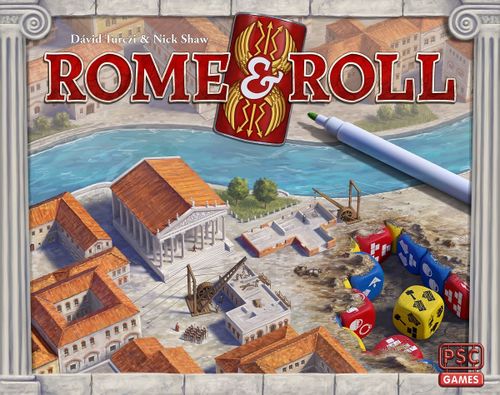
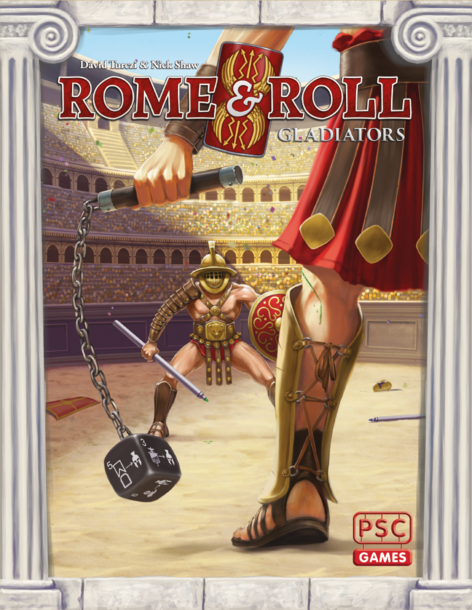
Gameplay Overview
In Rome & Roll, 1-4 players roll dice and select actions to rebuild Rome after the great fire of 64 AD. Here we will cover the gameplay for the base game as well as give you a preview of the Gladiators expansion due to hit Kickstarter on February 22, 2021 (learn more on the Kickstarter page here).
This is a general overview to provide context for the review, not an in-depth how to play. Some rules may be glossed over or missing.
Rome & Roll Base Game Overview
Setup
The game is set up with a central map of Rome that players draw buildings on. Surrounding the map are Blueprint cards (buildings to be built), God’s Favors (special abilities), and Nero cards (end game scoring).
Players begin with a dry erase character board with unique abilities and place their Overseer on the Forum in Rome. The first player receives the Pro Consul card (fancy schmancy first turn marker).
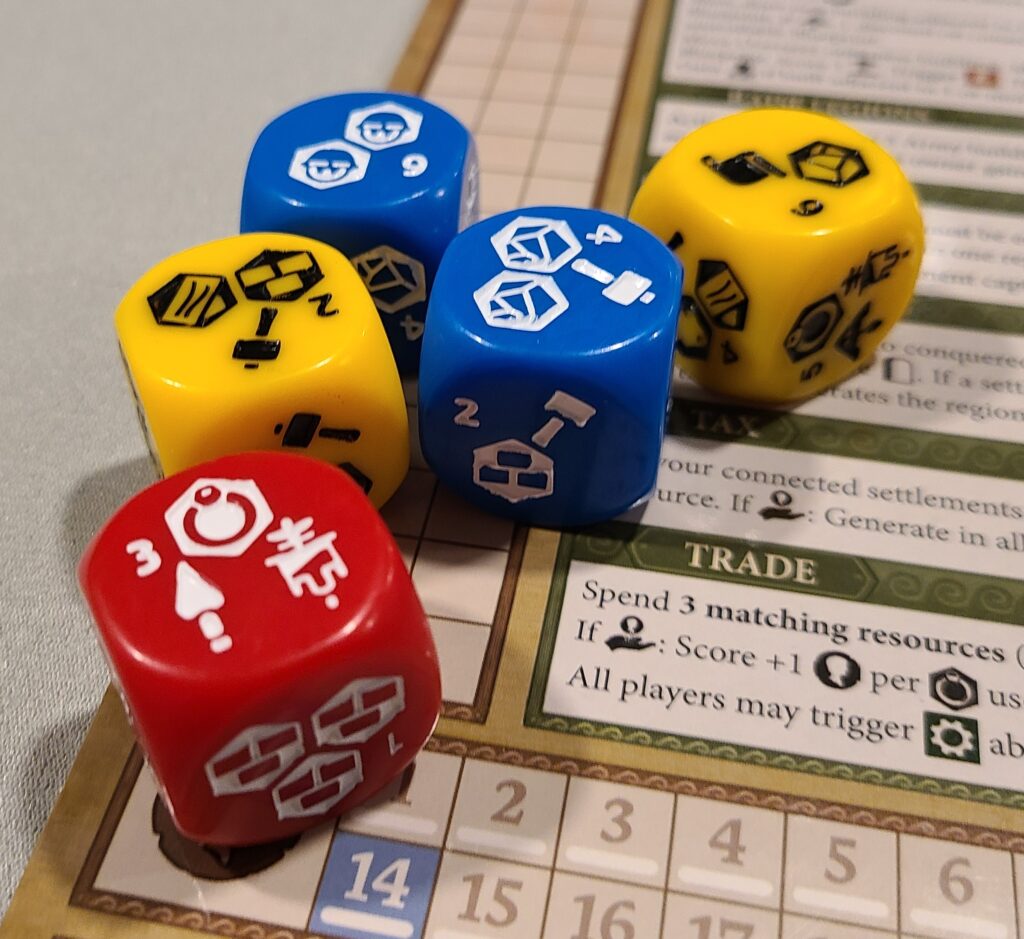
Round Overview
- The first player rolls all dice (# of dice depends on player count)
- In turn order, each player takes 1 dice
- In reverse turn order, each player takes a 2nd dice (last player takes 2 dice in a row)
Pro Tip: Your senators can be deployed to take your second die when you draft your first. This really comes in handy, especially when you have more than one very specific action or resources you need, so don’t forget about this option!
Actions
After all players have 2 dice, they take main actions in turn order until they’ve all used both dice.
Main Actions (there’s also a handy summary of these on the player boards):
- Construct: use die with builder or architect icons to select a building blueprint, pay the resource cost, and draw the building outline onto the map. Note: only architects can build blueprints that already have a player’s meeple on it.
- This is a sort of polyomino mechanism (think tetris) where each building has a specific shape that you can rotate, flip, etc to make it fit on the map
- You have to build next to the building containing your Overseer meeple. You can move before construction 1 building over + 1 fish per additional movement
- Pay attention – some blueprints have placement restrictions or immediate effects
- If you placed next to an opponent’s building, gain a senator (these are SUPER handy)
- Trigger the production of ALL adjacent buildings
Pro Tip: Construct is where you can do a bit of action chaining by thinking carefully about how your new building will trigger your adjacent buildings. And while Senators are great, remember constructing next to opponents also triggers their buildings, so make sure they aren’t getting something that they really needed.
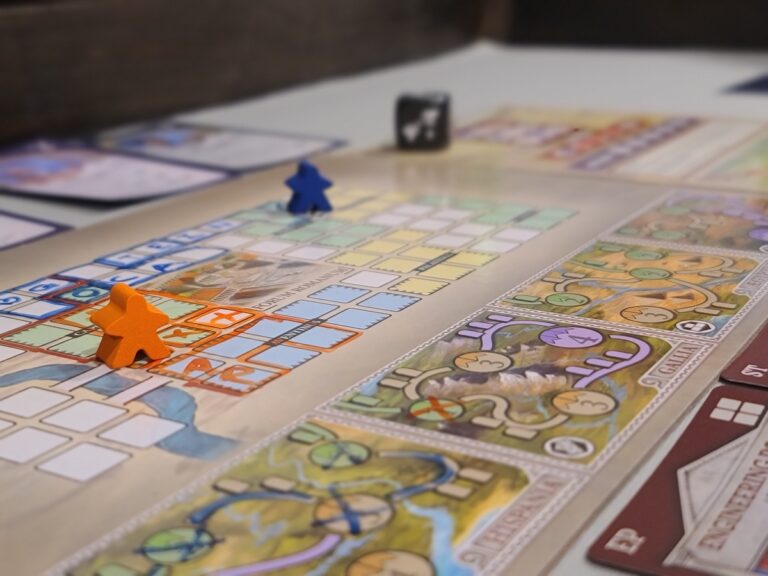
- Raise Legions: use die with Legionary icon and carry out the associated Legion ability on up to 3 Army buildings drawn on the board (opponents gain 1 coin if you use their building)
- Conquer: use any die to conquer one or more settlements in ONE region based on Army strength. Garrison (cross off) one soldier per settlement conquered (that soldier can’t contribute to conquer actions anymore)
- Expand: use die with Builder icon to renovate roads connecting conquered settlements back to Rome
Pro tip: You can renovate roads between opponent’s settlements.
- Tax: use any die to generate resources from all YOUR settlements connected to Rome in ONE region. Boost with a merchant icon
- Trade: use any die to trade 3 of one type of resource to get 3 coins. Boost with a merchant icon.
- All players activate one production ability on one of their buildings
- Free Actions: Can be done at any time, on any players turn (you will routinely do free actions on other player’s turns in response to their main action)
- Store – add unused resources on dice used for actions or resources gained on other players turns to your Storage Yard
- Bribe Advisor – unlock upgraded abilities and end game scoring
Pro Tip: Rome & Roll is an asymmetric game in that your chosen character has unique abilities, particularly around advisors. The advisor abilities can be super powerful, so let them influence your strategy!
Concepts:
- Senators: We already mentioned this, but senators can be used to take your second die at the same time as your first (guaranteeing an opponent won’t take it). They can also be used for specific icons if your die doesn’t have them (this is CLUTCH. Do people still say clutch?).
- God’s Favors: These cards are gained as a one time benefit from constructing a religious building and provide a 1-time super-powered boost to a specific action.
- Points Tracks: The bottom of each player board has 4 tracks: Coins, Buildings, Legacy (Roads), Glory (Conquer). Players mark off the lowest numbered box on the track each time they do the associated action (gain coins, build a building, etc). At game end, players score the highest marked box for each track.
- Nero Cards: The points tracks each have one blue box on them. When a player reaches the blue box, they gain a face-down Nero card.
Game End & Scoring
Game ends when the final Nero card is taken. Players tally up scores from buildings, advisors, point tracks, and more.
Rome & Roll: Gladiators Expansion
What's New?
Rome is in the process of being rebuilt and now the people (but really that Emperor Nero guy) demand entertainment. Rome & Roll: Gladiators adds a new black Gladiator die, new cards, Iron as a resource, and public advisors to Rome & Roll. Also, tic-tac-toe…what more do you need?!?
Overall, the expansion adds components and a few rules, but it integrates seamlessly with the base game. We felt like this expansion could (and maybe should) have been part of Rome & Roll all along.
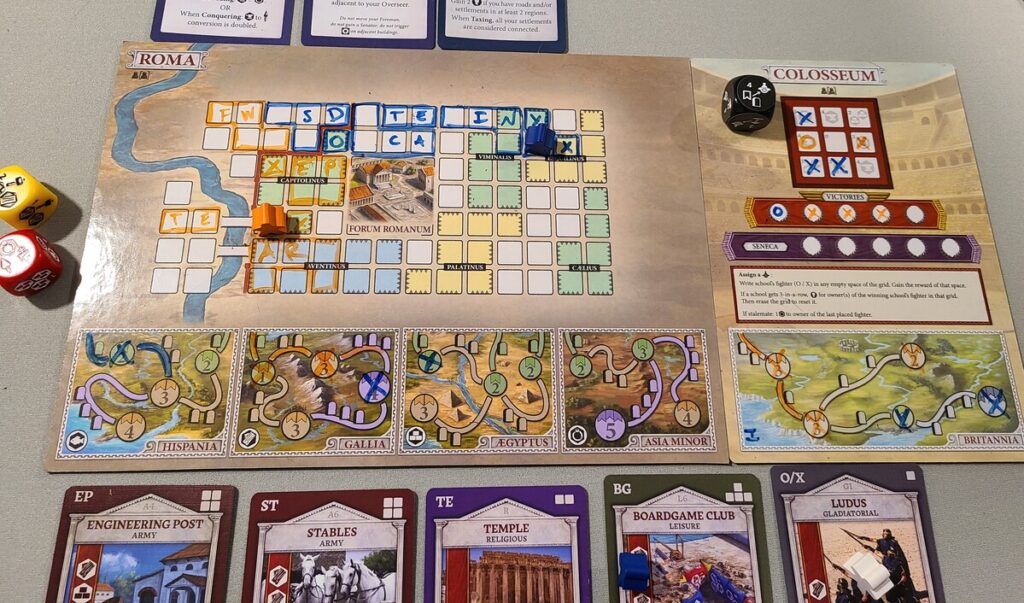
Key Rule Additions:
- Colosseum: Fancy Tic-Tac-Toe. The board houses the Gladiator arena (tic-tac-toe grid) and a new region for conquering
- Players can send Gladiators gained in a number of ways to draw X’s and O’s in the colosseum. 8 out of the 9 spaces have resources that are gained
- When a player completes a row of 3 X’s or O’s (with any combination of player colors), it’s a victory for the X or O school. Every player with that school on the grid gains a coin, and that school is recorded on the victory track. More on that in a bit.
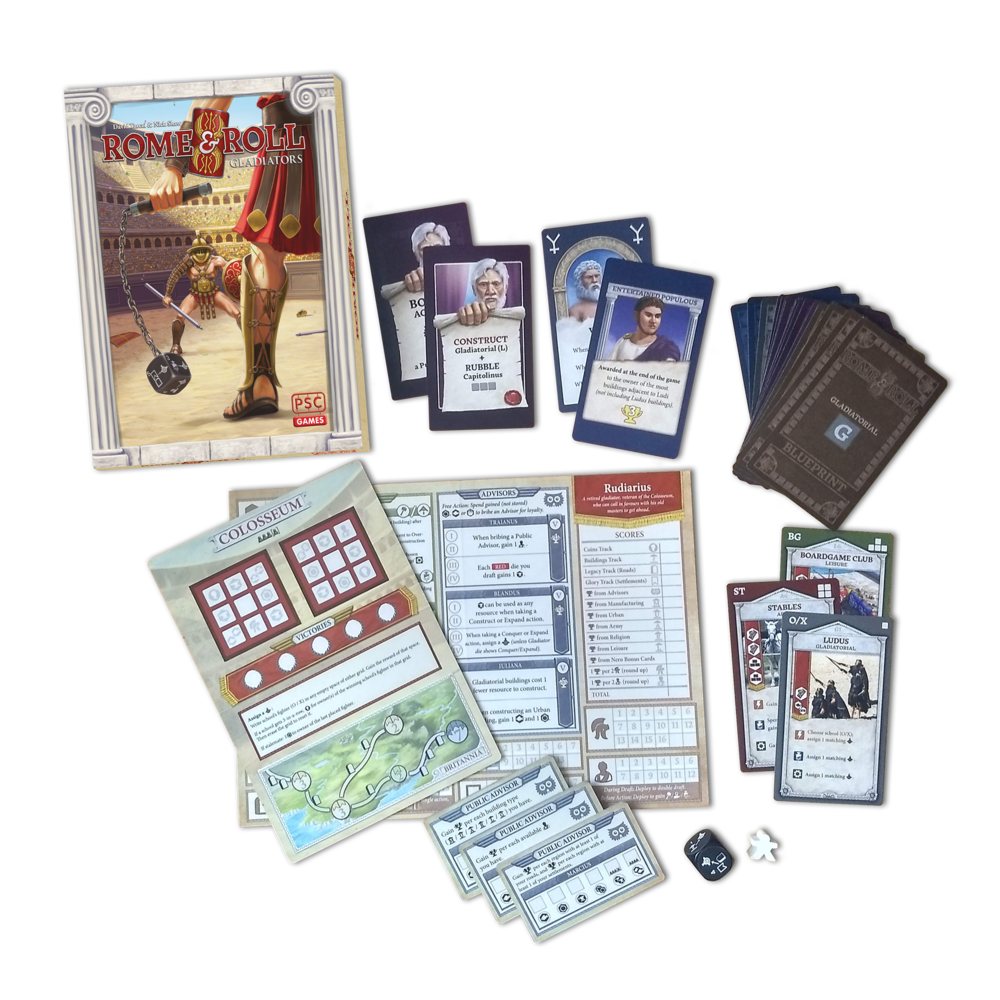
- Gladiators: A new symbol meaning you get to play tic-tac-toe in the colosseum
- Gladiator die: if you do a specific main action this turn, you get a gladiator at the end of your turn. Pick X or O as desired.
- Gladiator buildings: give you gladiators when built or during production
- Iron: A new type of resource
- Neutral Foreman: Now the 2-player variant from the base game is part of the regular rules – a neutral meeple is used to block off blueprints to add some restriction on construction
- New components: New buildings (some that give iron!), a new character, public advisors (points not abilities), new Nero cards, new gods’ favor cards
- New Game End Trigger: The expansion has 2 game end triggers:
- Run out of the Nero card deck (base game)
- Fill up the Colosseum victory track
What do we think?
If you look Rome & Roll up on Board Game Geek, you’ll see that it is categorized as being in the roll & write family/mechanism. And yes, it is technically a roll & write in that you’re rolling dice and then writing/crossing off/drawing things. We get it. But Rome & Roll is a far cry from games like That’s Pretty Clever or Yahtzee.
Instead, it’s much closer to a euro dice drafting and action selection game where you also happen to write stuff down on dry-erase boards. With that in mind, players should approach this game ready and willing to experience a bit of analysis paralysis trying to math out the best strategies.
Next we’ll mix up our usual format and tell you the pros/cons of the base game and the upcoming expansion.
TL/DR: You need the expansion.
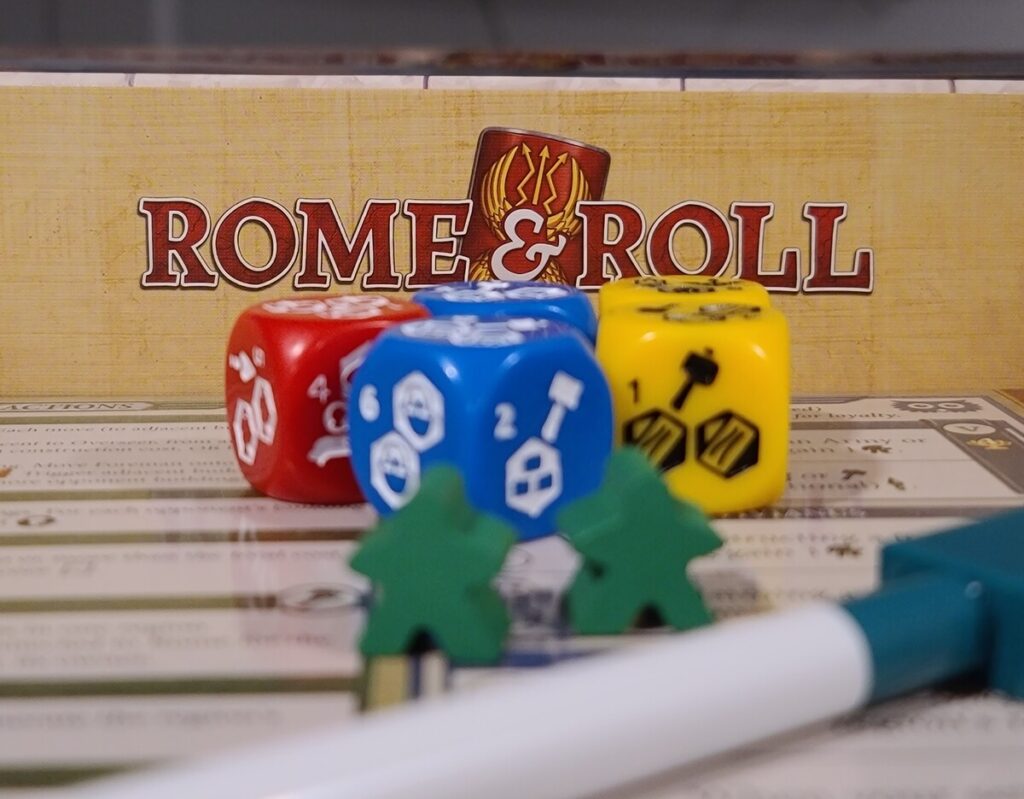
Base Game
The base game is a solid dice-selection strategy game. Does it get the brain juices flowing? Definitely. Is it the most exciting thing in the world? Not really. We classified the base game alone as a solid “fine” when thinking about it in the grand scheme of similar games.
What did we like?
At 2 players there is a “bot” variant that can be used to scale the game better, and we’d never play without it. It uses a randomized “3rd player” that makes gameplay scale much better, since it adds some tension that the game would be lacking at 2 players otherwise.
In general we’re huge fans of dice-selection euros like Troyes or Lorenzo and this fits right in with those, adding in the drawing mechanic. We like the mix of luck and skill involved: sure, there’s some uncontrollable randomness, but with a good, flexible strategy you have a lot of options to overcome bad luck or take advantage of good luck. At the end of the game, your score is up to how you play.
What didn't we like?
For us, the biggest drawback to the base game is the pacing. At 2 players, it feels like it takes forever, but you still aren’t doing a ton of things. It never quite feels like you “got going” by the time the game ends. Sure, there’s some engine building and chaining mechanisms that build throughout, but they’re just not exciting enough to justify the huge time commitment (takes us a bit less than an hour to play 2-player).
Rome & Roll: Gladiators Expansion
Daaaang this expansion kicks the game up a notch. It takes it from a bit ho-hum to super engaging, especially for 2 players. Whatever the base game seemed to be missing for us was solved with the addition of just a few extra things to think about. The expansion didn’t add much extra time to our game, still coming in just around 60min for a 2-player game (remember, dear reader, we’re often SLOW), so it fixed our pacing complaint.
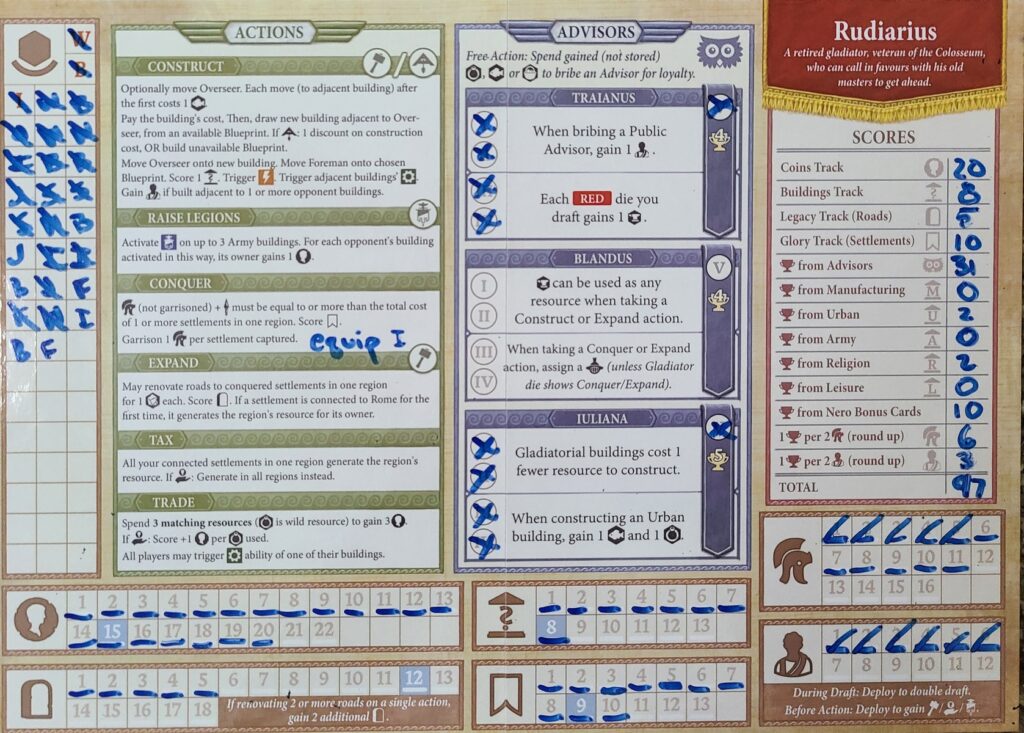
What did we like?
The Colosseum mechanism is great: tic-tac-toe at its finest. It’s an interesting way to get resources and points, and adds an extra oomph to your strategy. It’s not your tic-tac-toe of yesteryear and adds that missing bit of something fun and unique into what otherwise is a straightforward game.
We also really like that there are now two ways to trigger game end. We felt the Nero cards were a bit overweighted and made the game feel one-note. By adding the Colosseum, it forces players to react a lot more to each other and makes the game more dynamic.
The best part of the expansion was how seamlessly it joined with the base game. We’ve all played expansions where it feels tagged on, but Gladiators could have been part of the base game and we wouldn’t have noticed anything amiss. Especially for experienced gamers, if you are learning Rome & Roll for the first time, just get the expansion and go ahead and jump right in.
What didn't we like?
It’s tough to pinpoint gripes with an expansion, for us it solved a lot of our complaints from the base game and added fun new elements.
We do find the theme a bit tired and would like to urge publishers/designers to be a bit more creative. We understand that Ancient Rome/Gladiators is common theme for a LOT of media and it’s super important to remember parts of world history. BUT in general we feel a board game isn’t an appropriate way to learn/remember horrible things in human history, since too often it comes across as celebrating these awful things humans have done (like forcing slaves to fight to maim/death for entertainment).
Sarah's Take
Rome & Roll is a really interesting game for me. I love roll & writes but can’t stand drawing or spatial games. That being said, I wasn’t super thrilled with the drawing buildings aspect of Rome & Roll, but was excited to have a whole bunch of spaces to cross off.
Being in the mindset of playing a roll & write, I was initially a little let down honestly. I started asking myself, “why does this game have to be a roll & write”? I even told Emily that I thought I would like the game more if it was a worker placement game with tile laying for the buildings. Then lightbulb! That’s exactly what this is.
Rome & Roll is a really clever take on traditional mechanisms. I really love the asymmetric advisor abilities and generally let that drive my strategy for each game. But I also love that the game really rewards diversifying. Going hard on just one thing is absolutely something I struggle with, so I really appreciate a game that lets me have the sample platter instead of committing to a single plate.
I am absolutely delighted that there’s a tic-tac-toe mechanism in the Gladiators expansion. Yes, the tic-tac-toe brings back some nostalgic fun, but Gladiators overall really adds another level to the base game. It gives you more to do, more resources to trigger free actions, and makes the game even more interactive while heightening your awareness of what your opponent is doing on each turn.
Emily's Take
I love games with a spatial element mixed in! I’m going to be honest, Rome & Roll the base game was a bit…meh for me. It was like too much, yet not enough? It’s like it wanted to be a quick-playing medium weight game, but was weighed down with decisionmaking that didn’t have a lot of satisfying payoffs. There were moments that were great, like finally producing on a bunch of buildings because I placed a new building really well. But in between it was like I was waiting for things to happen. It wasn’t a bad game, just didn’t super stand out among all our other similarly-weighted games.
But then we got the expansion, and it 100% turned my opinion around. Just a few extra things to think about, and suddenly the payoff was immensely more satisfying for the amount of work I was putting into the strategy. Good news, too, that the game didn’t really get much longer for us!
I’m still working on perfecting my approach – I always tend to shy away from building near Sarah, but there are definite benefits to sticking close together. Sarah also mentioned that it’s a game about diversifying, since you can get points from so many sources, and that’s something I struggle with. In our last play 31 of my 98 points came from my advisors and the public advisors. I still won, but I ended up scoring “0” in several categories and I think I can do better!
Now I’m planning for the next game…
Breakdown
Rulebook / Learning the game
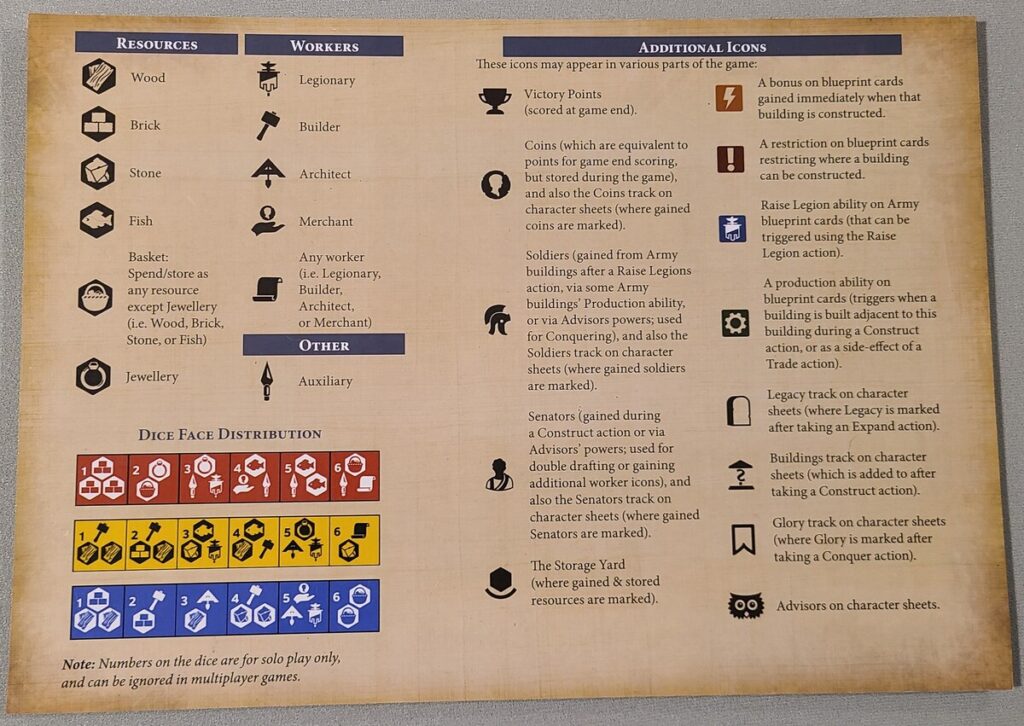
We found the rulebook to be clear and well laid out. It’s pretty long with a lot of repetition, but for us that just means it was super clear to follow with a ton of examples.
We can’t comment a lot on the expansion rulebook since we saw a prototype version, but it seems to be similar to the base game.
First Play
Base Game: Our first play of base Rome & Roll we did not use the 2 player variant. We felt that without the variant the game was too open. We are also, generally, conflict avoidant players, and played our first game happily off on our own sides of the map from each other made it really difficult to get Senators.
Expansion: Our first play of the Gladiators expansion had us instantly excited. Halfway through the game it was clear that some of our complaints about the base game were fixed.
Subsequent Plays
In our additional plays of base Rome & Roll we preferred the 2 player variant. We also realized the importance of playing off each other for building – getting Senators, trigger production, etc.
The addition of the Gladiators expansion changed the entire game for us. Honestly, even if it’s your first play of Rome & Roll, it’s not THAT much to just start off the bat with the expansion built in, especially for experienced gamers.
Parent Perspective
Interruptions
Rome & Roll is fairly interactive with players gaining benefits, triggering production, etc on opponents turns, so a pause for the 20th “goodnight song” of the night will halt gameplay for the entire table. However, because this is a dice drafting game, it can be somewhat difficult to plan too far ahead, so interruptions are not game breaking and it’s relatively easy to jump back in, even with songs from Frozen stuck in your head.
Time Investment
Rome & Roll takes us a solid hour to play a 2 player game. We did feel that the Gladiators expansion sped that up slightly but still plan on a solid 30 minutes/person overall. Because it’s heavily interactive for a euro-style game, time flies and doesn’t feel like a full hour to play.
The setup and takedown is also not super challenging, it’s basically just the boards, the different types of cards, player pieces and the dice. Took us about 5 min to set up and 5 min to put away.
Life Fit
Clocking in at just about an hour puts Rome & Roll with the Gladiators expansion is in the weeknight category for us. Rome & Roll is a game we will break out when we are wanting something a bit heavier than a roll & write but something that lets us get set up and playing in no time.
Rating
Rome & Roll base game alone: 6/10
Rome & Roll with Gladiators Expansion: 7.5/10
Rome & Roll with Gladiators is an interactive game that is friendly to interruptions from your 3 year old who just HAS to know what would happen if the Lion King took place in Jurassic Park (sorry kiddo, the Lions are probs getting eaten). When we want to play a game that gives us an opportunity to directly interact with each other and throw down with competitive tic-tac-toe, Rome & Roll with Gladiators is exactly what we’ll be reaching for.
*See our rating scale HERE
HERE is a link for the Kickstarter preview page. Kickstarter launching Feb 22, 2021.
Click through for more posts, or follow us on social media to see what we’re playing and for new post updates!
